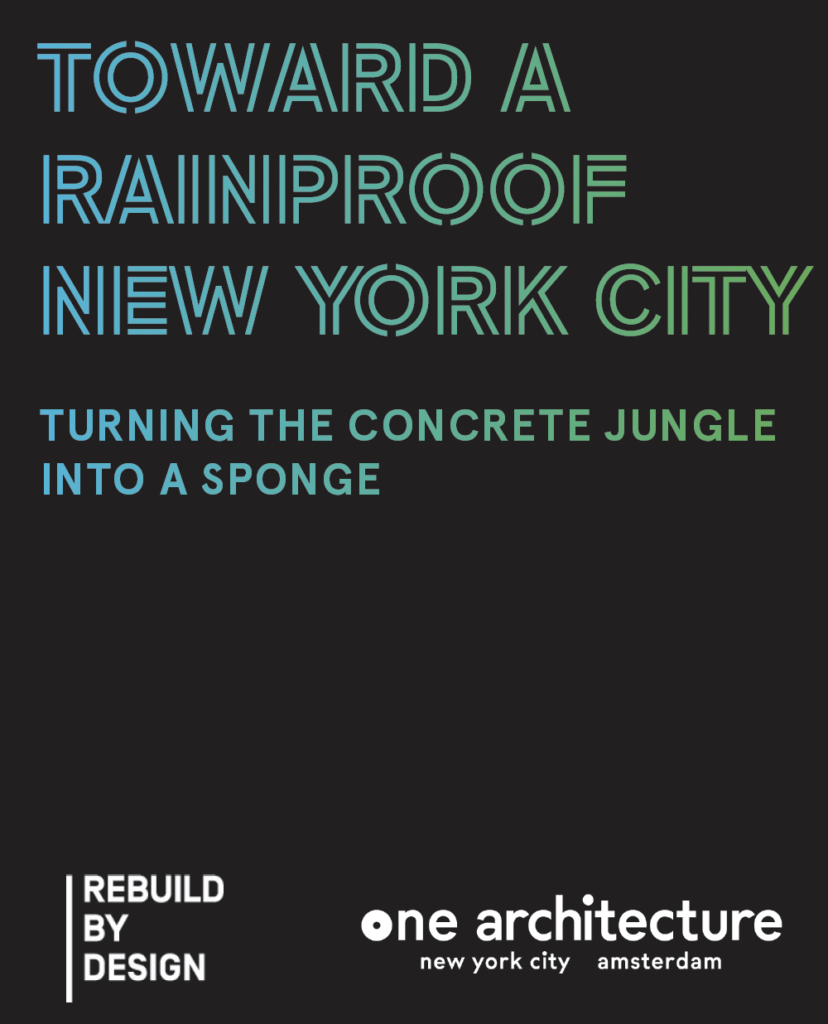RAINPROOF NEW YORK CITY SYMPOSIUM
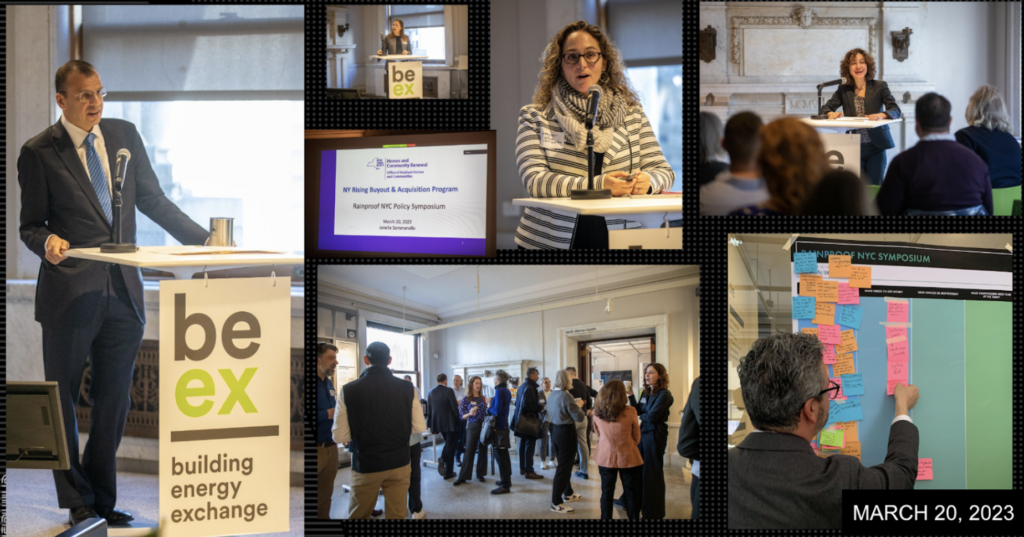

On March 20, 2023 Rebuild by Design, One Architecture & Urbanism, the NYC Department of Environmental Protection, and the NYC Mayor’s Office of Climate & Environmental Justice held a hands-on symposium with dozens of stakeholders, 16 government agencies, and international experts to workshop solutions to drive policy and practices towards a Rainproof NYC.
The symposium explored solutions to ensure New Yorkers can thrive in the face of increasing heavy rainfall, and will focus on three topics:
CHALLENGE 1: To address the gaps with current infrastructure and capacity issues to manage 100 percent of the projected increase from heavy rain events so New Yorkers can continue with their daily lives.
CHALLENGE 2: To create a citywide housing migration program informed by the most impacted communities.
CHALLENGE 3: To work together to build the capacities of communities, the private sector, NGO’s, and other agencies to do their part in managing increased heavy rainfall.
AGENDA
8:45AM Doors open
9:30AM Introductory Remarks
Amy Chester, Managing Director, Rebuild by Design
Rohit Aggarwala, NYC Chief Climate Officer & Commissioner, New York City Department of Environmental Protection
9:50AM Panel 1: Living with Water & Managing 100% of the Increased Heavy Rainfall
Lykke Leonardson, Program Director Resilient and Sustainable City Solutions – City of Copenhagen, Denmark
David Waggonner, Principal – Waggonner & Ball
Sophia Ertel, Climate Adaptation Engineer – Ramboll
Jennifer Gonzalez, Director of Environmental Services & Chief Sustainability Officer – City of Hoboken, New Jersey
10:40AM Panel 2: Climate Migration
Anna Weber, Senior Policy Analyst, Healthy People & Thriving Communities Program – NRDC
Courtney Wald Wittkop, Blue Acres 3.0 Program Manager – New Jersey Department of Environmental Protection
Jannelle Sommerville, Deputy Director, Housing, Buyout & Acquisition Programs – Governor’s Office of Storm Recovery
Jennifer Correa, Resident
Kristin Marcell, Director – Climigration Network
11:30AM Break
11:45AM Deputy Mayor Meera Joshi Remarks
12:00PM Panel 3 : In this Together
Aaron Levy, Division Director, Individual and Community Preparedness – FEMA
Lot Locher, Co-Initiator and Strategist – Amsterdam Rainproof & International Director – One Architecture & Urbanism (ONE)
12:30PM Lunch Break
1:15PM Breakout Round 1 (60 minutes)
2:15PM Breakout Round 2 (40 minutes)
2:55PM Breakout 3 (20 minutes)
3:15PM Closing Remarks
4:00PM Event Concludes
special thanks to con edison for supporting this event
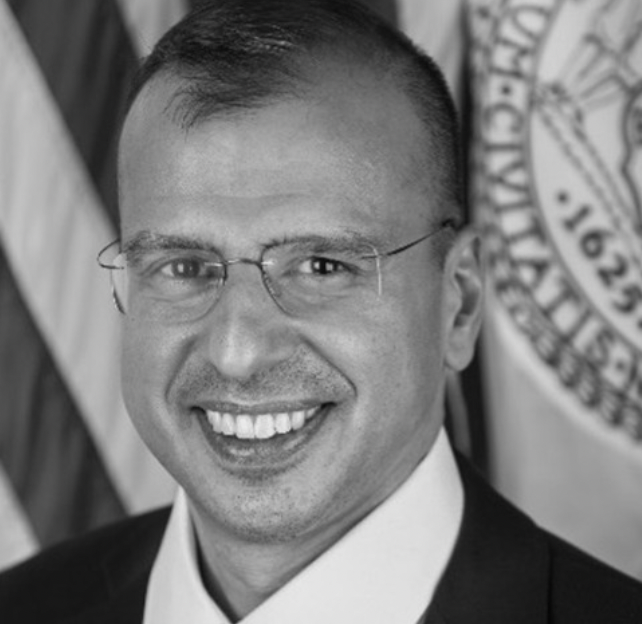
Rit Aggarwala
Commissioner, NYC Department of Environmental Protection
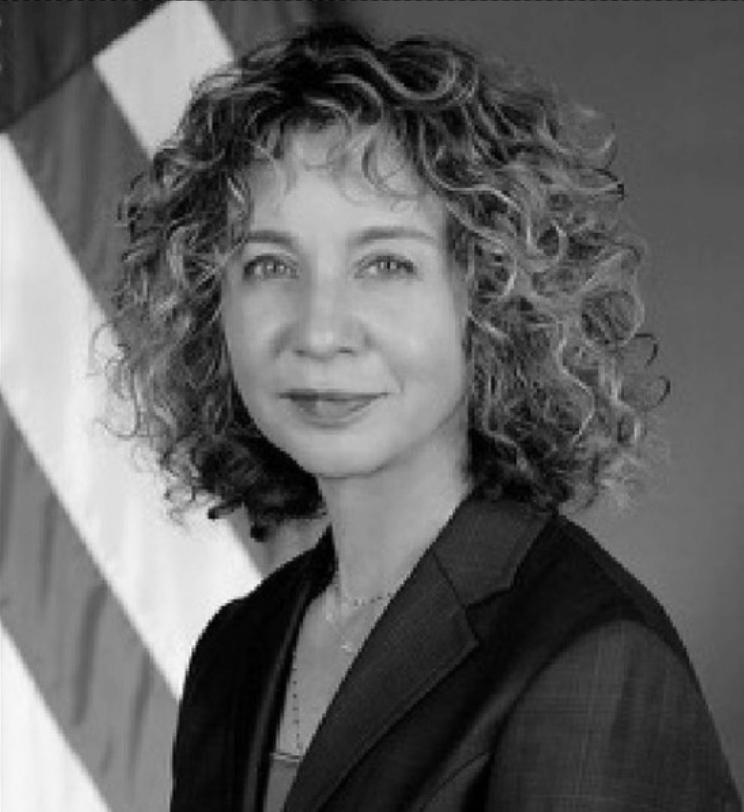
Meera Joshi
New York CIty Deputy Mayor for Operations
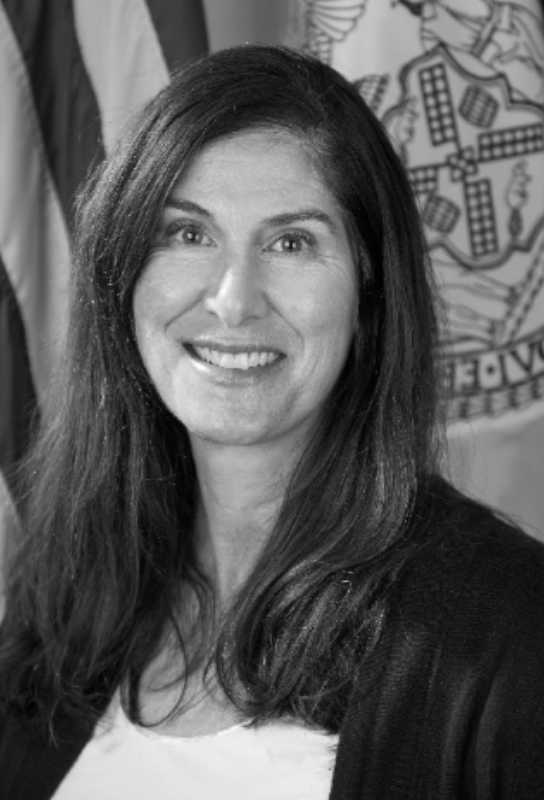
Angela Licata
Deputy Commissioner for Sustainability, New York City Department of Environmental Protection
PANELISTS

Lykke Leonardsen
Program Director Resilient and Sustainable City Solutions – City of Copenhagen, Denmark
Ms. Lykke Leonardsen has worked with urban development for the past 25 years in Copenhagen. This includes local regeneration projects, international urban policies and communication. Since 2008 she has worked for the Technical and Environmental Administration in charge of making Copenhagen more blue and green – in charge of water management and green infrastructure planning. It was as part of this work that the city’s Climate Change Adaptation plan was developed.
From 2014-2016, she was the Head of the Climate Unit, in charge of the Climate Change Adaptation program, and the city’s ambitious plan to be the first carbon neutral capital of the world before 2025. Since 2016, she has been Head of program for Resilient and Sustainable City Solutions. Ms. Leonardsen has a Master in Near Eastern Archaeology and Master of Public Policy.

David Waggonner
Principal – Waggonner & Ball
David is the founding principal of Waggonner & Ball, an internationally active architecture and environment practice based in New Orleans. David was raised in Plain Dealing, Louisiana and spent time in Washington, DC, where his father was a U.S. Congressman. He is a graduate of the Yale School of Architecture, and in 2010 was elevated to the position of Fellow in the American Institute of Architects (FAIA). In 2016, David was awarded the AIA Louisiana Medal of Honor. From preservation to modern architecture to urban design, locally and internationally, quality and innovation are hallmarks of his work. His maxim, “know where you are,” imparts both an understanding of place and a critical awareness of time.
In the aftermath of Hurricane Katrina, David saw an opportunity for New Orleans to reinvent itself as a sustainable city that embraces its lifeblood: water. He championed a process that examines history, soils, biodiversity, infrastructure networks, urban space and habitation, along with the forces of water. This combination serves as a holistic foundation for design, initiated during the Dutch Dialogues, developed through the Greater New Orleans Urban Water Plan, and now being implemented in multiple projects including the city’s winning National Disaster Resilience Competition (NDRC) entry. Related processes and efforts have produced Rebuild by Design and other NDRC awards for Bridgeport, Connecticut, and the States of Louisiana, Connecticut, and Virginia.

Sophia Ertel
Climate Adaptation Engineer – Ramboll
Sophia Ertel works in an engineering and planning capacity on climate resiliency master planning, blue-green infrastructure design and integrated water management programs. Her background in Civil Engineering lends to modeling, mapping, and design of climate adaption projects. At the same time, Sophia leads stakeholder engagement efforts on planning projects prioritizing climate justice and promoting equitable solutions. Her current project portfolio is diverse and ranges from New York City neighborhood-level planning for flood mitigation to international collaboration on visualization tools for scenario planning of Blue-Green Infrastructure. Sophia received her Bachelor’s in Civil Environmental Engineering from The George Washington University and is currently based in Ramboll’s New York City office.
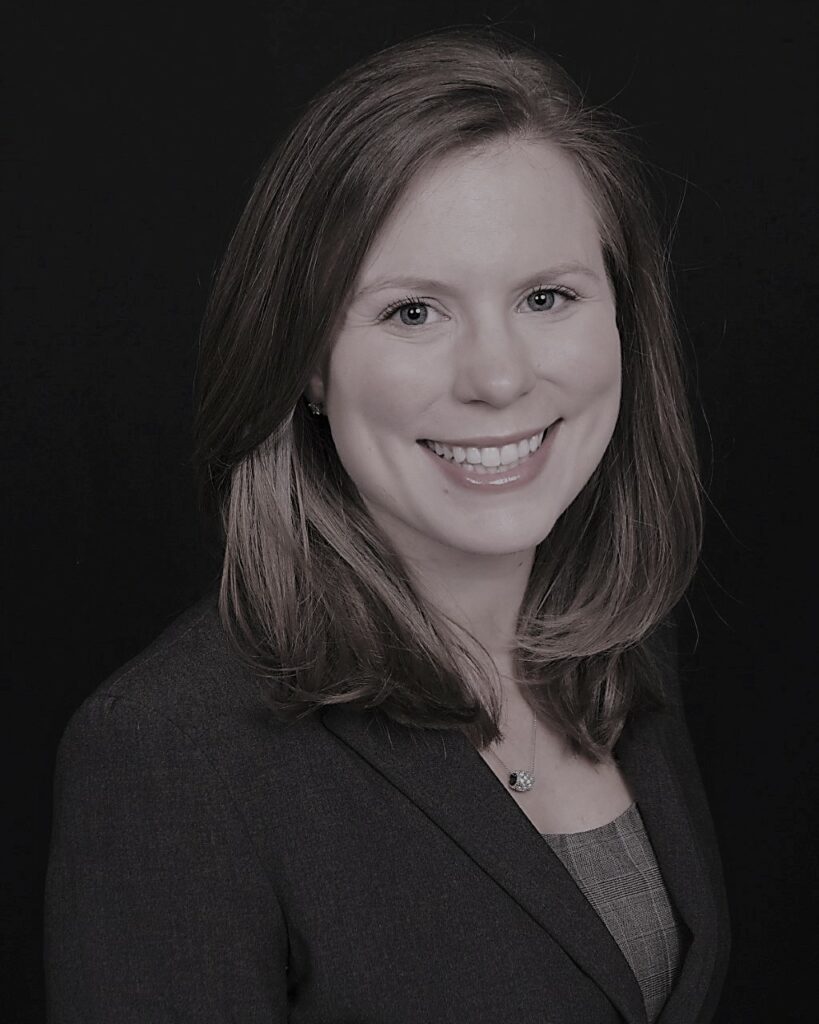
Jennifer Gonzalez
Director of Environmental Services & Chief Sustainability Officer – City of Hoboken, New Jersey
Jennifer Gonzalez is the Director of Environmental Services and Chief Sustainability Officer for the City of Hoboken, New Jersey where she oversees public works including parks, recreation, public property, waste management, fleet maintenance, and infrastructure projects including flood risk reduction. She advances asset management, sustainability in municipal operations across multiple departments, and resiliency projects such as the resiliency parks. She also supports emergency management, the Hoboken drinking water utility, and coordination with energy and sewer utilities. Before joining the City of Hoboken, Ms. Gonzalez was a Principal Planner with Louis Berger and Environmental Planner with the County of Passaic, New Jersey. She holds professional certifications from the American Planning Association (AICP), National Assocation of Floodplain Managers (CFM), U.S. Green Building Certification Institute (LEED-Green Associate), and New Jersey Board of Professional Planners (PP).

Anna Weber
Senior Policy Analyst, Healthy People & Thriving Communities Program – NRDC
Anna Weber’s work seeks to incorporate the current and future effects of flooding, sea level rise, and other climate-driven hazards into local, state, and national decision-making and to ensure that adaptation policies benefit those on the front lines of climate change. Prior to joining NRDC in 2018, she spent ten years at the Cadmus Group, where she supported U.S. Environmental Protection Agency contracts related to water infrastructure and environmental health. She holds a bachelor’s degree from Williams College and a master’s of public health from the George Washington University. She is based in NRDC’s Washington, D.C., office.
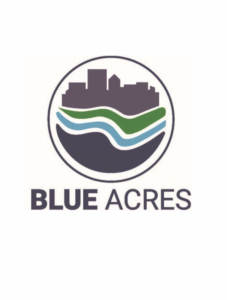
Courtney Wald Wittkop
Blue Acres 3.0 Program Manager – New Jersey Department of Environmental Protection
Ms. Wald-Wittkop leads the Blue Acres planning team, which incorporates climate resilience planning
into the design and execution of proactive, voluntary flood buyouts. Courtney believes that an
interdisciplinary approach is necessary to address the impacts of climate change, esepcailly in under
resourced and socially vulnerable communities. During her 17 years at NJDEP, she has applied for and
secured over $300 million in federal grants. She is a committed bridge builder, who has worked with
various state and federal agencies, communities, and partners to protect New Jersey’s natural resources
and to expand open space and outdoor recreation opportunities across the state. She has a background
in land acquisition and open space planning. Courtney received a Master ‘s degree in Land Use
Geography and Planning from Rutgers, the State University of New Jersey in New Brunswick and a
Bachelor’s degree in Environmental Studies and Geography from the University of Colorado, Boulder.

Janelle Sommerville
Deputy Director, Housing, Buyout & Acquisition Programs – NYS Office of Resilient Homes and Communities.
Jannelle Sommerville has been working on the Buyout program for over five years with a focus on program policy and disposition of over 560 open space properties through building partnerships with local governments, nonprofit organizations, and neighbors. She has an interdisciplinary background in environmental science and policy with an MPA from Columbia University’s School of International and Public Affairs and previous experience on international research grants with the Earth Institute.

Jennifer Correa
Former Resident, Oakwood Beach, Staten Island
After Hurricane Sandy destroyed her “forever home” in 2012, Correa and her family worked with their neighbors to convince Governor Cuomo to create a buyout program that would help affected residents move to safer ground. The Correa’s participated in the New York State buyout program, leaving their home after only seven years, and taking advantage of the State’s incentives to stay close to their community. The Correa’s now live in Pleasant Plains, Staten Island.

Kristin Marcell
Director, Climigration Network
Kristin Marcell is a program designer, coordinator, and director with more than 16 years of experience managing partner networks and assistance programs that build the collaborative capacity for partners to innovate on technical, funding, outreach, leadership development, and decision-support challenges in the field of climate adaptation. She serves the Network with a belief that building power with Tribal and BIPOC communities will bring wisdom to decision making in the climate crisis and is essential to create a new, just community-led relocation process in the US.
Before becoming Network Director, Kristin led the Climate Resilience Program for the New York State Department of Environmental Conservation’s Hudson River Estuary Program in a partnership with Cornell University. She coordinated with state, regional and local government and a diverse group of partners to advance regional and statewide climate adaptation research, policy and design.
Kristin holds a Master’s degree from Tufts University in Urban and Environmental Policy and Planning and a Bachelor’s degree from Clark University in Biology. She’s also served in local government, on the Environmental Commission and Planning and Zoning Committee in the Town of Rochester, New York. She is based in Moses Lake, Washington, where she lives with her wife, two boys, and a cadre of rescued dogs and cats.

Aaron Levy
Director of FEMA’s Individual and Community Preparedness Division (ICPD)
Aaron Levy is the Director of FEMA’s Individual and Community Preparedness Division
(ICPD) where he leads the Agency’s efforts to help people prepare for disasters. Aaron oversees
programs that partner at all levels of government, the private sector, and community
organizations to increase citizen and community preparedness and encourage the development of disaster resilience across the Nation.
Aaron joined FEMA in December 2010 as a congressional affairs specialist. Prior to taking up his current position in September 2019, Aaron served as the Executive Officer (XO) of FEMA’s National Preparedness Directorate (NPD). As XO, Aaron was the de-facto chief operating officer of a business line consisting of 400 full time employees, across three geographical locations with an annual budget of $400 million. He provided counsel to NPD’s Assistant and Deputy Assistant
Administrators on the directorate's strategic, budgetary and operational priorities while managing the staff of the Office of the Assistant Administrator. From January-April 2020, Aaron served on temporary assignment as Senior Advisor to the Acting FEMA Administrator where he provided executive counsel on the whole of government efforts to provide COVID-19 vaccinations to the American people.
Aaron graduated from Richmond, The American International University in London with a
Bachelor of Arts in International Relations and subsequently received his Master of Arts in
Global Security Studies from Johns Hopkins University. Aaron also completed the Executive
Leaders Program at the Naval Post Graduate School’s Center for Homeland Defense and Security. A native of New Jersey and lifelong New York Giants fan, Aaron resides in Washington, D.C. with his wife Katie, their amazing daughter Carolyn and a lovable labradoodle named Sunny.

Lot Locher
Co-Initiator and Strategist – Amsterdam Rainproof & International Director – One Architecture & Urbanism (ONE)
Prior to joining ONE as the International Director for Climate, Lot Locher set up the now-internationally-acknowledged initiative, Amsterdam Rainproof (2013), linking her international experience in architecture, urbanism, and landscape architecture to urban climate adaptation. Based on its success, Lot scaled up the program, combining it with other successful network approaches to urban climate adaptation, into a new nationwide organization, Together Climate Proof, part of the Dutch watermanagement Delta Program Adaptation (2018). As program manager for Waternet, the Utility company of the waterboard Amstel Gooi and Vecht and the watertasks of the Municipality of Amsterdam, she helped to make the low-lying Metropolitan Region of Amsterdam, future proof.
At ONE, Lot combines her experience of setting up programs and initiating public-private networks with practical design experience in climate and water projects (e.g., cloudburst resilience, heat, drought, and floodproof and sustainable urban development). Her drive and social skills help her stimulate change in the policies and practices of the various actors in the urban realm.
RAINPROOF GLOSSARY
BLUE-GREEN INFRASTRUCTURE (BGI) – Connects urban hydrological functions (blue) with vegetation systems (green). (NYC DEP)
CLOUDBURST EVENT – A ‘cloudburst’ is a sudden, heavy downpour where a lot of rain falls in a short amount of time. Cloudbursts can cause flooding, damage property, disrupt critical infrastructure, and pollute New York’s rivers and Harbor. (NYC DEP) Note: “cloudburst” is often used interchangeably with “rainbomb,” “extreme rainstorm,” “extreme rainfall,” or “extreme precipitation.” This report uses the term extreme rainstorm to describe events like Hurricane Ida.
CONVEYANCE SYSTEM – A system such as drainage pipes, streets, and bluebelts that directs water flow to be retained or detained by permeable surfaces, detention sites, or retention sites.
DAYLIGHTING – an approach that exposes some or all of a previously buried river, stream, or stormwater drainage. (American Rivers)
DETENTION SYSTEM – An integrated approach to store water temporarily during a high precipitation event, such as green roofs, green-blue roofs, park space, bioswales, berms, sunken basketball courts, and sunken playgrounds.
GREEN INFRASTRUCTURE (GI) – The range of measures that use plant or soil systems, permeable pavement or other permeable surfaces or substrates, stormwater harvest and reuse, or landscaping to store, infiltrate, or evapotranspirate stormwater and reduce flows to sewer systems or to surface waters. (Water Infrastructure Improvement Act). Green infrastructure systems can reduce stormwater flooding.
NATURAL INFRASTRUCTURE – Uses existing, restored, or enhanced ecosystems to generate infrastructure outcomes either on its own or in combination with built infrastructure. (International Institute for Sustainable Development)
NATURE-BASED SOLUTIONS – Sustainable planning, design, environmental management and engineering practices that weave natural features or processes into the built environment to promote adaptation and resilience. (FEMA)
SMART INFRASTRUCTURE – Uses real time data to inform and deploy systems using sensors, cameras, and other monitoring devices.
STORM SURGE – The rise in seawater level caused solely by a storm. (NOAA)
RETENTION SYSTEM – An area that stores water on a more permanent basis, such as ponds, reservoirs, and streams.
BLUE-GREEN INFRASTRUCTURE (BGI) – Connects urban hydrological functions (blue) with vegetation systems (green). (NYC DEP)
CLOUDBURST EVENT – A ‘cloudburst’ is a sudden, heavy downpour where a lot of rain falls in a short amount of time. Cloudbursts can cause flooding, damage property, disrupt critical infrastructure, and pollute New York’s rivers and Harbor. (NYC DEP) Note: “cloudburst” is often used interchangeably with “rainbomb,” “extreme rainstorm,” “extreme rainfall,” or “extreme precipitation.” This report uses the term extreme rainstorm to describe events like Hurricane Ida.
CONVEYANCE SYSTEM – A system such as drainage pipes, streets, and bluebelts that directs water flow to be retained or detained by permeable surfaces, detention sites, or retention sites.
DAYLIGHTING – an approach that exposes some or all of a previously buried river, stream, or stormwater drainage. (American Rivers)
DETENTION SYSTEM – An integrated approach to store water temporarily during a high precipitation event, such as green roofs, green-blue roofs, park space, bioswales, berms, sunken basketball courts, and sunken playgrounds.
GREEN INFRASTRUCTURE (GI) – The range of measures that use plant or soil systems, permeable pavement or other permeable surfaces or substrates, stormwater harvest and reuse, or landscaping to store, infiltrate, or evapotranspirate stormwater and reduce flows to sewer systems or to surface waters. (Water Infrastructure Improvement Act). Green infrastructure systems can reduce stormwater flooding.
NATURAL INFRASTRUCTURE – Uses existing, restored, or enhanced ecosystems to generate infrastructure outcomes either on its own or in combination with built infrastructure. (International Institute for Sustainable Development)
NATURE-BASED SOLUTIONS – Sustainable planning, design, environmental management and engineering practices that weave natural features or processes into the built environment to promote adaptation and resilience. (FEMA)
SMART INFRASTRUCTURE – Uses real time data to inform and deploy systems using sensors, cameras, and other monitoring devices.
STORM SURGE – The rise in seawater level caused solely by a storm. (NOAA)
RETENTION SYSTEM – An area that stores water on a more permanent basis, such as ponds, reservoirs, and streams.
